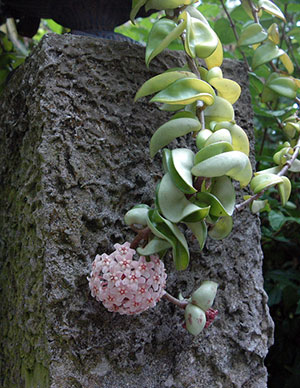Hoya
 As with fashion, some plants never go out of style. Hoya is a classic houseplant that still manages to turn heads, thanks to its attractive leaves, fragrant flowers, and easy-care nature.
As with fashion, some plants never go out of style. Hoya is a classic houseplant that still manages to turn heads, thanks to its attractive leaves, fragrant flowers, and easy-care nature.
Characteristics
Gardeners typically grow hoya plants for the small clusters of sweet-smelling, star-shaped flowers that they produce.
Hoyas are trailing vines that have woody stems and thick, fleshy leaves that are waxy and give the plant one of its common names—wax plant. The leaves can vary greatly in size, shape, and color, depending on the species and variety. The cultivar 'Variegata' has white-margined leaves, 'Exotica' has yellow and pink variegated leaves with green margins, and 'Krinkle Kurl' has curved leaves that look like fortune cookies.
Between 200 and 300 species of hoya are found in the world, and wax plant (Hoya carnosa) is probably the most commonly cultivated hoya. Other types that are grown as houseplants include miniature wax plant (H. lanceolata bella) and common waxflower (H. australis).
Planting and Care
Plant your hoya in a hanging basket that will allow its long tendrils to hang freely. The vines sometimes twine around themselves or other structures, so you may need to gently untangle them at times.
Your hoya will perform best indoors if placed in a window where it can receive bright light. It can also be grown outdoors as long as it isn’t exposed to temperatures below 45°F or to too much direct sun, which can burn its foliage.
Water it regularly from spring through fall, allowing the top third or half of the soil to dry out completely between waterings. In the winter, water very sparingly.
After your hoya finishes flowering, take care to avoid damaging the base of the flowers. The plant uses these parts, called peduncles, to produce its next round of blooms. If your plant never flowers, check to see that it’s receiving a suitable amount of light, since this is usually the main reason that hoyas don’t flower.
It’s best to re-pot hoyas only when necessary. However, it’s easy to make new hoya plants by rooting stem cuttings. Since hoyas are related to milkweed and have a milky sap, take care not to let the sap from cut stems drip onto furniture.
Hoyas can sometimes be susceptible to mealy bugs, which are small, cottony insects that appear on the stems or undersides of the leaves. Treating an affected plant with a horticultural soap spray or an approved systemic insecticide will usually remedy the situation.
For more information on hoya, contact your county Extension office.

